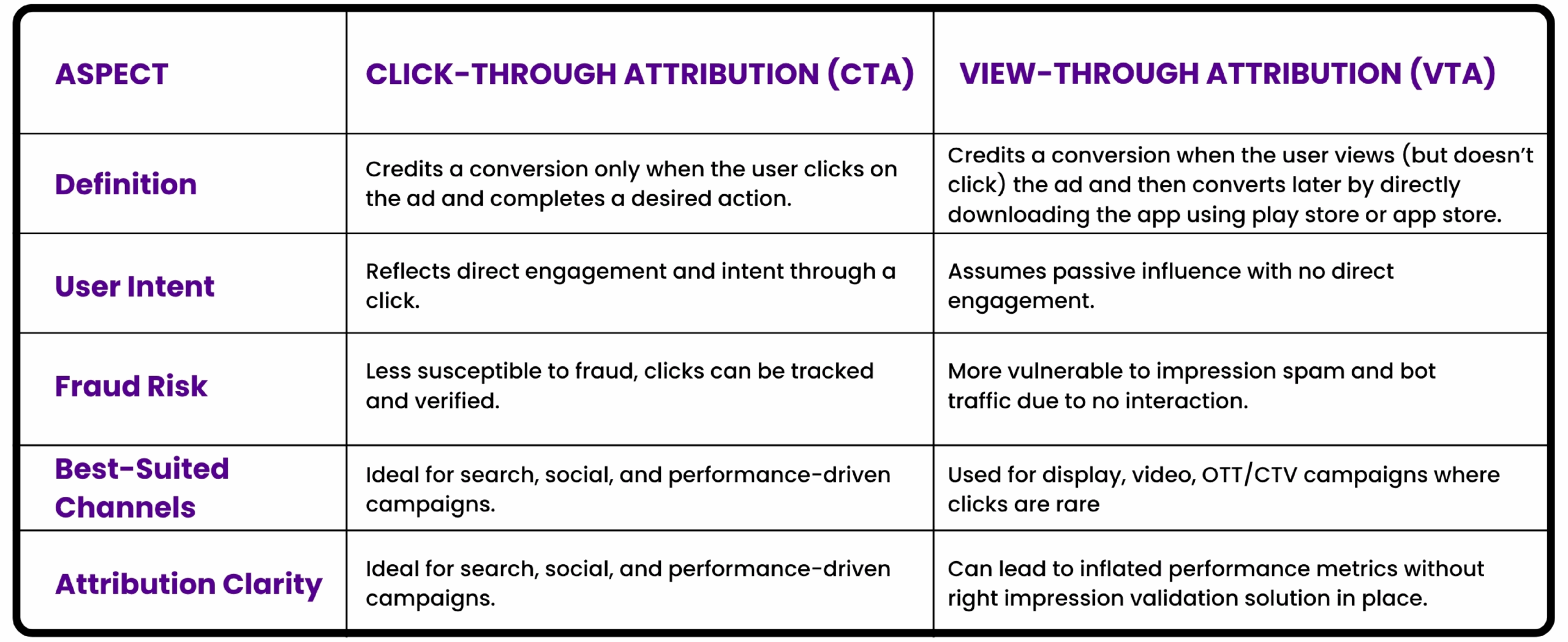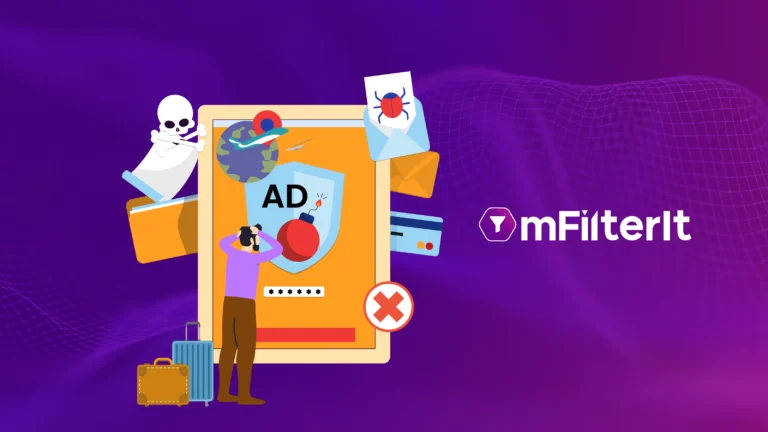While marketers focus on driving installs and scaling campaigns, there’s a silent threat that’s bleeding budgets dry – Impression Spam. These are fake or hidden impressions generated to manipulate attribution models and steal credit for app installs, especially through View-Through Attribution (VTA).
On the surface, everything looks great. High impression counts, rising install numbers, good reach. But beneath, you’ll often find invalid impressions that were never actually seen by real users. Here’s the uncomfortable truth: if your VTA numbers are spiking without corresponding clicks, your ads are likely being targeted.
Impression spam doesn’t just distort your data; it rewards fraudsters, inflates costs, and hijacks installs that should have been credited to genuine traffic or organic users. That’s where impression validation becomes non-negotiable.
In this article, we’ll talk about how impression spam works, what red flags to watch for, and how mFilterIt helps you bring transparency back to your attribution funnel with impression integrity.
Why Impression Spam Happens?
Most marketers use both Click-Through Attribution (CTA) and View-Through Attribution (VTA) to measure performance. While CTA requires a user to click on an ad before converting, VTA allows installs to be credited based solely on an impression, if the user later installs the app within the attribution window.
This is where the impression fraud creeps in. VTA opens the door for bad actors to take advantage of attribution systems, inflate VTA that allow installs to be attributed even when no click happens, just by showing an impression.
What is the Difference Between Click Through Attribution & View Through Attribution?
While both CTA and VTA serve distinct purposes in performance measurement, their attribution mechanics differ significantly. Here’s How:

Why is High VTA Ratio a Problem?
One of the major indicators of impression spam is an abnormally high View-Through Attribution (VTA) rate, particularly when it significantly exceeds your Click-Through Attribution (CTA) numbers. As a general benchmark, if more than 60% of your attributed installs are coming through VTA, it calls for a close audit.
It is very less likely for a user to see an ad, not click on it but remember it and later search for the app on play store to install. This kind of user journey is possible, but when it appears on a scale, it’s statistically improbable.
An inflated VTA rate often signals that impressions are being generated in unusual ways:
- Impression stuffing: Multiple invisible ads loaded at once, none of which are truly viewable.
- Background ad rendering: Ads shown in hidden browser tabs or apps running in the background.
- Bot traffic: Automated scripts mimic user behavior, including fake impressions and subsequent app installs, to game attribution making it appear as though an ad influenced the install. When in reality, no meaningful user engagement occurs.
And while these installs might look normal on the surface (matching attribution windows, geographies, and even device models), they usually show poor post-install performance: no session activity, zero events triggered, and very high uninstall rates.
On the other hand, a healthy performance-driven campaign should have a balanced ratio of CTA to VTA, especially when you’re targeting engaged users with clear calls to action. While VTA can play a valuable role in measuring upper-funnel awareness (particularly for display, video, or CTV ads), it should not dominate your attribution model, especially if your campaign objective is direct response or installs.
How Impression Spam Hurts Your Campaigns? (Some Red Flags You Shouldn’t Ignore)
Impression spam affects campaign son multiple basis:
- Wasted Budget: You end up paying for impressions that never reached real users.
- Skewed Performance Data: Optimization decisions based on fake data lead to flawed strategy.
- Fraudulent Payouts: You reward the wrong sources, while genuine traffic partners get undervalued.
- Organic Hijacking: Fraudsters take credit for installs that would’ve happened anyway, distorting your organic benchmarks.
- Poor ROI on User Acquisition: Invalid impression drives low quality installs affecting return on investment as well as LTV
And if you’re wondering how to spot impression spam in your performance data, here are a few red flags to keep an eye on:
- High VTA, Low CTA: A disproportionate number of installs attributed to views over clicks.
- Short impression-to-install windows: Installs happening unusually fast after impressions are served.
- Low post-install engagement: Users attributed through VTA show poor retention or event completion.
- Traffic from non-targeted geographies: This is clearly indicative of impression stuffing or bot activity.
Do you know ad fraud is not limited to just impressions? Learn how it impacts your bottom line in this blog.
How mFilterIt Helps You Detect and Block Impression Spam
Stopping impression spam isn’t just about identifying invalid impressions; it’s about restoring trust in your data and ensuring that every impression that enters your attribution funnel is validated and has impression integrity. That’s exactly what we do for our clients.
Our advanced ad fraud detection solution helps protect the very first touchpoint of the user journey – impressions. Here’s how:
1. Impression Integrity Validation
Our tool validates each impression based on multiple parameters – device authenticity, placement, location, timestamp accuracy, etc. It ensures that impressions are not only technically served, but also actually seen by real users under acceptable conditions.
2. Granular VTA vs. CTA Disparity Checks
It also helps analyze attribution patterns and conversion timelines, proactively detect anomalies in View-Through Attribution ratios. If the VTA numbers rise disproportionately compared to Click-Through Attribution, it flags the issue before the whole campaign is compromised.
3. Bot Install Detection Linked to Impression Trails
Many fraud schemes use bots that not only generate fake impressions but also simulate full-funnel activity. Our tool identifies such bot installs by linking post-install behavior to suspicious impression patterns. This helps uncover impression fraud that traditional MMPs overlook.
4. Source-Level Blacklisting and Partner Insights
Our proprietary impression validation solution also gives complete visibility to monitor all traffic sources. Once identified, these sources are automatically flagged or blacklisted, reducing budget wastage at the earliest stage.
We have helped Kuku FM improve their engagement by validating their ad traffic. Learn how.
Conclusion: Protect Your Campaigns with Valid8
In today’s fragmented digital advertising landscape, simply counting impressions isn’t enough anymore; you need to know they were real, valid, and viewable.
Impression spam exploits the grey areas of attribution and rewards the wrong behavior. With fraud detection tool by mFilterIt, you don’t just track impressions, you validate them. From detecting bot-driven installs to uncovering inflated VTA ratios, our advanced impression validation tool ensures every impression counts, and every dollar works harder for you.
Want to see how impression integrity can transform your campaigns?
Connect with our experts today.



